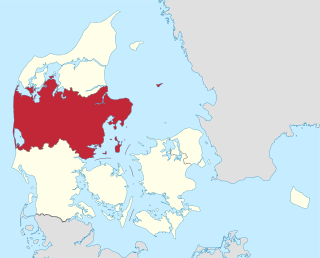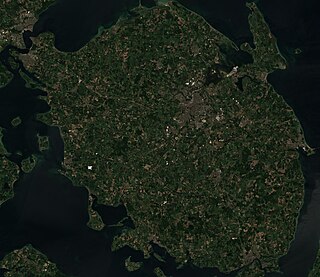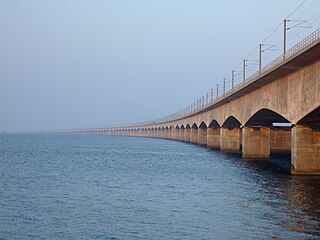
Transport in Denmark is developed and modern. The motorway network covers 1,111 km while the railway network totals 2,667 km of operational track. The Great Belt Fixed Link connecting the islands of Zealand and Funen and the New Little Belt Bridge connecting Funen and Jutland greatly improved the traffic flow across the country on both motorways and rail. The two largest airports of Copenhagen and Billund provide a variety of domestic and international connections, while ferries provide services to the Faroe Islands, Greenland, Iceland, Germany, Sweden, and Norway, as well as domestic routes servicing most Danish islands.

Odense is the third largest city in Denmark and the largest city on the island of Funen. As of 1 January 2024, the city proper had a population of 183,763 while Odense Municipality had a population of 209,078, making it the fourth largest municipality in Denmark. Eurostat and OECD have used a definition for the Metropolitan area of Odense, which includes all municipalities in the Province of Funen, with a total population of 504,066 as of 1 July 2022.

Middelfart is a town in central Denmark, with a population of 16,528 as of January 2024. The town is the municipal seat of Middelfart Municipality on the island of Funen.

DSB, an abbreviation of Danske Statsbaner, is the largest Danish train operating company, and the largest in Scandinavia. While DSB is responsible for passenger train operation on most of the Danish railways, goods transport and railway maintenance are outside its scope. DSB runs a commuter rail system, called the S-train, in the area around the Danish capital, Copenhagen, that connects the different areas and suburbs in the greater metropolitan area. Between 2010 and 2017, DSB operated trains in Sweden.
Higher education in Denmark is offered by a range of universities, university colleges, business academies and specialised institutions. The national higher education system is in accordance with the Bologna Process, with bachelor's degrees, master's degrees and doctoral degrees. The majority of higher education institutions are the responsibility of the Ministry of Higher Education and Science; however, some higher education institutions within the arts are the responsibility of the Ministry of Culture.

Hans Tausen (Tavsen) nicknamed the “Danish Luther” was the leading Lutheran theologian of the Danish Reformation in Denmark. He served as Bishop of Ribe and published the first translation of the Pentateuch into Danish in 1535.

The rail transport system in Denmark consists of 2,633 km of railway lines, of which the Copenhagen S-train network, the main line Helsingør-Copenhagen-Padborg, and the Lunderskov-Esbjerg line are electrified. Most traffic is passenger trains, although there is considerable transit goods traffic between Sweden and Germany.

The Central Denmark Region, or more directly translated as the Central Jutland Region and sometimes simply Mid-Jutland, is an administrative region of Denmark established on 1 January 2007 as part of the 2007 Danish municipal reform. The reform abolished the traditional counties (amter) and replaced them with five new administrative regions. At the same time, smaller municipalities were merged into larger units, cutting the total number of municipalities from 271 to 98. The reform diminished the power of the regional level dramatically in favour of the local level and the national government in Copenhagen. The Central Denmark Region comprises 19 municipalities.

The former Diocese of Odense was a Roman Catholic diocese in Denmark which included the islands of Funen, Langeland, Tåsinge, Lolland, Falster, Als, and Ærø. Its episcopal see was located in Odense at St. Canute's Cathedral.

Jutland Art Academy, is a state recognized institute for higher education in Aarhus, Denmark, offering a 5-year programme in contemporary art. The academy has no departments and focuses on conceptually driven practices and transdisciplinary work. The academy has about 50 students. The school is located in the street of Mejlgade in the Latin Quarter of Aarhus.

Funen, with an area of 3,099.7 square kilometres (1,196.8 sq mi), is the third-largest island of Denmark, after Zealand and Vendsyssel-Thy. It is the 165th-largest island in the world. It is located in the central part of the country and has a population of 469,947 as of 2020. Funen's main city is Odense, which is connected to the sea by a seldom-used canal. The city's shipyard, Odense Steel Shipyard, has been relocated outside Odense proper.
The 1927–28 Danmarksmesterskabsturneringen i Fodbold was the 1st edition of the new year-long league structure for the Danish national football championship play-offs, a Danish FA-organised club football tournament between the highest ranking clubs from each of the six regional football associations. The national tournament at the top of the Danish football league system consisted of two stages, a preliminary round contested by 20 teams split into 5 groups determined by draw and distributed evenly among all regional associations, where the five winners of each group would qualify for the final championship round held at the end of the season. The clubs participating in the nationwide competition were also simultaneously contesting in their local regional league championships.

The Copenhagen–Fredericia/Taulov Line is the Danish railway line between the capital, Copenhagen, and the Jutland peninsula by way of the islands of Zealand and Funen. It is administered by Banedanmark and has a length of about 220 kilometres (140 mi). Being one of the main arteries of the Danish railway network, it has double track and is fully electrified.
Sydbank A/S is one of Denmark's largest full service banks headquartered in Aabenraa. Sydbank was founded in 1970 with the merger of four local banks based in Southern Jutland: Den Nordslesvigske Folkebank (Aabenraa); Graasten Bank (Gråsten); Folkebanken for Als og Sundeved (Sønderborg) and Tønder Landmandsbank (Tønder). It has since then grown considerably through mergers and acquisitions, one of the latest being DiskontoBanken of Næstved, which was delisted on the Copenhagen stock exchange as of 15 January 2014. It has 57 branches including three in Germany.

Thomas Arboe was a Danish architect.
Wermund Bendtsen was a Danish professional photographer, filmmaker and photojournalist active in Odense from the 1940s to the 1980s.

Ottine Caroline Emilie Andersen (1895–1970) was a Danish historian and archivist. An intricate researcher, her first published work Grams Historie (1926) was a detailed history of the Gram Estate at Gram in the south of Jutland which she undertook for its owner Adolph Brockenhuus Schack. After working for the Provincial Archives of Southern Jutland and then those of Zealand, in 1958 she was engaged by the National Archives where she developed a legendary competence in documenting historical records, in particular the archives of Christian II, integrating sources from Stockholm and Oslo. The corresponding registry titled München-Samlingen was published in 1969 as Volume 15 of Vejledende Arkivregistraturer.

The Western Regional Command was the overall command of all Royal Danish Army units in Jutland and on Funen. It was split into four military regions, and was responsible for the regional defence. In 1990, the Regional Commands were disbanded and control was collected at the newly created Army Operational Command.

Constituencies are used for elections to the Folketing, the national parliament of Denmark. Denmark proper is divided into 10 constituencies largely corresponding to the Provinces of Denmark, each electing multiple members using open-list proportional representation. Those constituencies are then divided into 92 opstillingskredse which mainly serve the purpose of nominating candidates, but historically functioned as single-member constituencies electing one member using plurality voting.

The 2023–24 Danish Cup, also known as Oddset Pokalen, was the 70th season of the Danish Cup competition.



















